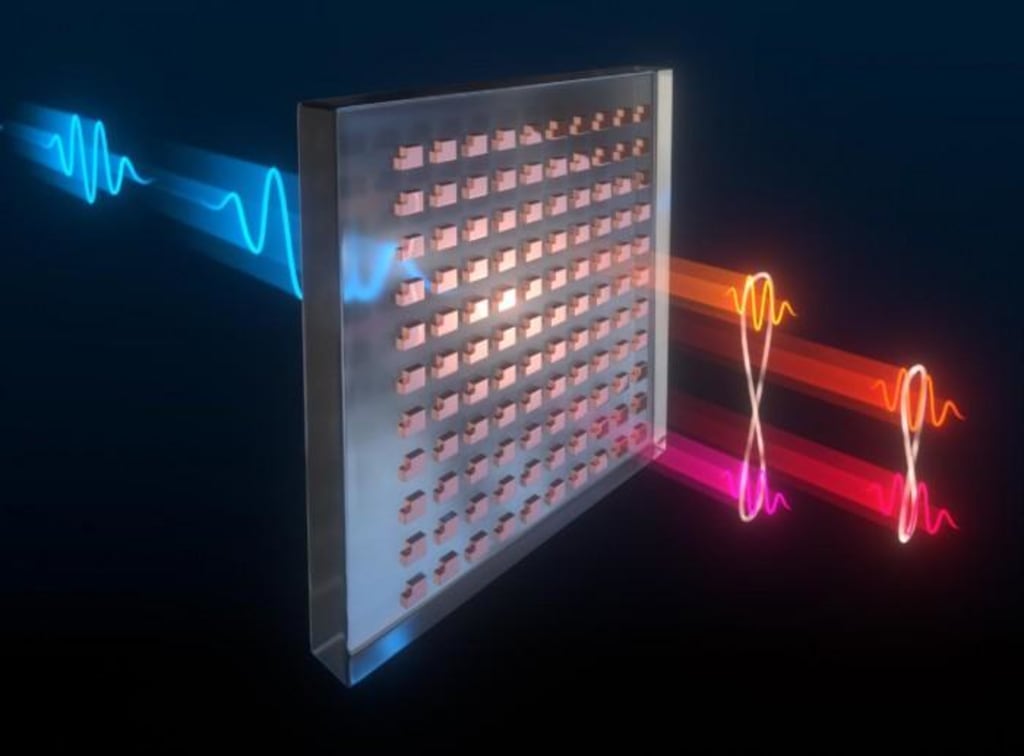The strangest and most useful phenomena in quantum mechanics
Could make future computing, sensing and encryption technologies significantly smaller and more powerful

By helping scientists control a strange but useful quantum mechanical phenomenon, an ultra-thin invention could make future computing, sensing, and encryption technologies significantly smaller and more powerful. The device is described in a new study recently published in the journal Science.
According to scientists at Sandra National Laboratories and the Max Planck Institute for the Science of Light, the device could replace a room full of devices that link photons in a bizarre quantum effect known as entanglement. It is a nano-engineered material called a meta surface that paves the way for entangling photons in a complex way that is not possible in compact technology.
When photons are said to be entangled, it means that they are linked in such a way that action on one photon affects another, no matter where in the universe those photons are or how far apart they are. This is a bizarre effect of quantum mechanics, a law of physics that governs particles and other very tiny things.
As strange as this phenomenon may seem, researchers have used it to process information in new ways. For example, entanglement helps protect fragile quantum information and correct errors in quantum computing, an area that could one day have sweeping implications for science, finance, and national security. Entanglement could also provide advanced new encryption methods for secure communications.
The groundbreaking device is a hundredth the thickness of a sheet of paper, and its research was conducted in part at the Center for Integrated Nanotechnology, a user facility of the U.S. Department of Energy's Office of Science, operated by Sandra and Los Alamo National Laboratory. Sandra's team received funding from the Office of Science's Basic Energy Sciences Program.

The new metasurface serves as a "gateway" to this unusual quantum phenomenon. In some ways, it resembles the mirror in Lewis Carroll's Alice in the Mirror, through which the young protagonist Alice experiences a strange new world.
Instead of walking through their new device, the scientists shine a laser through it. The beam passes through an ultra-thin glass sample covered with nanoscale structures made of a common semiconductor material called gallium arsenic.
"It disrupts all the light fields," says Sandra senior scientist Gal Brenner. He is an expert in a field called nonlinear optics and leads the Sandra team. Occasionally, he said, a pair of entangled photons of different wavelengths emerge from the sample in the same direction as the incoming laser beam.
Brenner said he is enthusiastic about the device because it is designed to produce a complex network of entangled photons. Instead of producing just one pair at a time, it can produce several pairs of photons that are all entangled, and some that can be indistinguishable from each other. Some technologies require these complex so-called multiple entangled varieties to implement complex information processing schemes.
Although other micro technologies based on silicon phonics can also entangle photons, they lack the much-needed level of complex multiple entanglements. Until now, the only way to produce such results was to use multiple tables filled with lasers, specialized crystals, and other optical devices.
When these multiple entanglements require more than two or three pairs, it is quite complex and somewhat difficult to solve," Brenner said. These nonlinear metasurfaces essentially achieve this task in a single sample, which previously required incredibly complex optical setups."
The Science paper outlines how the team successfully tuned their metasurfaces to produce entangled photons with different wavelengths. This is a key precursor to producing several pairs of intricately entangled photons at the same time.
However, the scientists note in their paper that the efficiency of their device - the rate at which they were able to produce groups of entangled photons - was lower than other techniques and will need to be improved.
What is a meta surface?
A metasurface is a synthetic material that interacts with light and other electromagnetic waves in ways that traditional materials cannot. the commercial industry is busy developing meta surfaces because they take up less space and can do more with light than traditional lenses, Brener said.
"You can now replace lenses and thick optical elements with metasurfaces," Brenner said. "These types of metasurfaces are going to revolutionize consumer products."
Sandra National Laboratories is one of the world's leading institutions researching metasurfaces and metamaterials. Between its Microsystems Engineering, Science, and Applications Complex, which makes compound semiconductors, and its nearby Integrated Nanotechnology Center, scientists have access to all the specialized tools they need to design, fabricate and analyze these ambitious new materials.
This work is challenging because it requires precise nanofabrication techniques to obtain the sharp, narrow-band optical resonances that are the seeds of the quantum processes in this work," said Sylvan Genaro, a former postdoctoral fellow at Sandra who was involved in several aspects of the project.
The device was designed, fabricated, and tested through a collaboration between Sandra and a research group led by physicist Maria Chekhov. She is an expert in photogenic quantum entanglement at the Max Planck Institute for the Science of Light.
Tomas Santiago-Cruz says, "Meta surfaces are leading to a paradigm shift in quantum optics, combining ultra-small quantum light sources with the far-reaching possibilities of quantum state engineering." He is a member of Max Planck's team and the first author of the paper.
Brenner, who has studied metamaterials for more than a decade, said this latest research could spark a second revolution - seeing these materials used not only as a new lens but as a technology for quantum information processing and other new applications. There is a wave of meta surface technologies that are well established and underway," he said. There may be a second wave of innovative applications coming up."
About the Creator
Mao Jiao Li
When you think, act like a wise man; but when you speak, act like a common man.






Comments (1)
🌹